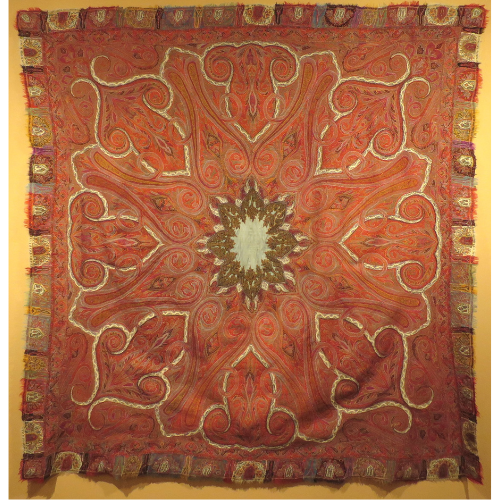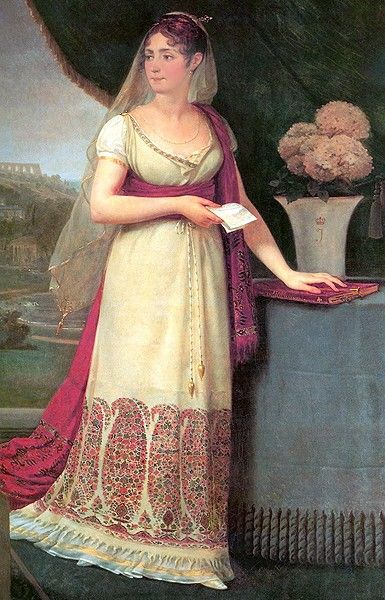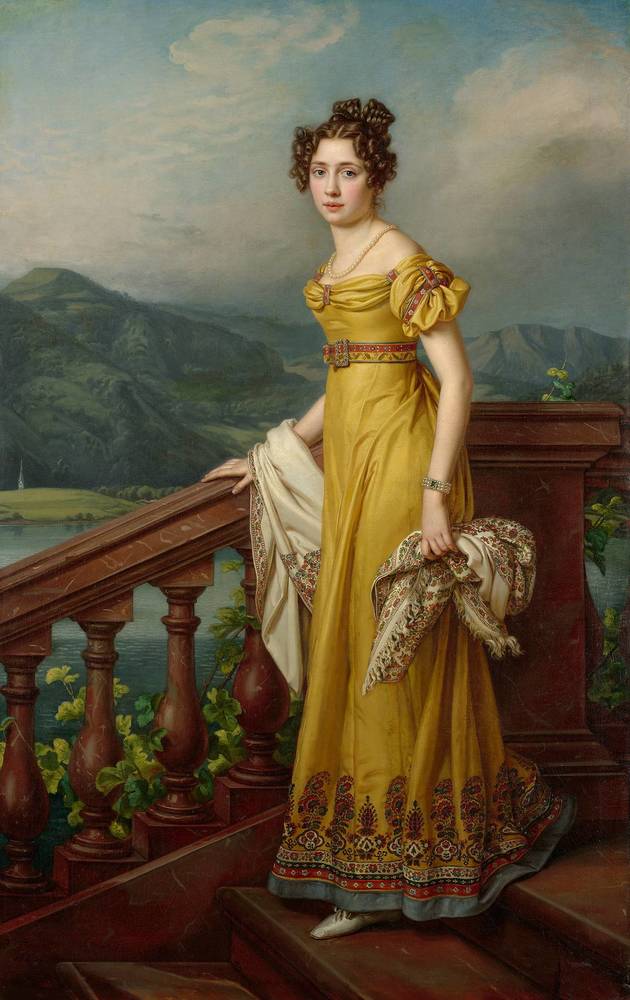Introduction
The Kashmir shawl has a long and rich history, dating back several centuries. Originating in the Kashmir valley of the Indian subcontinent and to a lesser extent eastern Iran, these shawls were highly prized all over Asia throughout antiquity for their intricate patterns, luxurious materials, and incredible craftsmanship. Recorded through time repeatedly by Buddhist monks from late antiquity China to the medieval court scribes of the Mughals, the craftmanship, indigenous to the region has been unparallel.
This article attempts to trace the journey of the Kashmir shawl and its adaptation across the globe through the surviving examples in collections around the world, particularly The Zay Initiative and other sources such as contemporary paintings and literature.

Two men, one bowing to the other in an orange shawl Mughal Miniature c. late 17th century; Acc No IS.48:29/B-1956; Source: Small Clive Album, V&A

Women in white with narrow pink edging, orange with narrow white edging and pink with narrow green edging shawls, Mughal Miniature c. 18th century; Acc No IS.48:36/A-1956; Source: V&A
The unique selling point:
Woven from the finest fleece from the underbelly of the Himalayan chanthangi goats from the Ladakh province. the fabric is locally known as pashmina. The term is derived from the Persian and Hindustani word pašm, meaning wool and is now commonly synonymous to the finished product.

Portrait of Begum Samru; wearing a Kashmir shawl; holding a huqqa-snake; draped curtain behind her, by Jiwan Das, Company Painting, Delhi c. 1830; Acc No 03554(IS); Source: V&A
The adoption of Kashmiri shawls in Europe
It is not quite clear when and how this eponymous item of luxury was introduced to the European market. Although available to the Russian market, its reach to Western Europe is not known until the latter part of the eighteenth century.
Legend has it that Napoleon and his French officers had brought the shawls to France from Egypt. They were made fashionable by Madame Emile Gaudin at Paris and Versailles, eventually resulting in a thriving trade between Europe and the Levant where these shawls already had a thriving market as winter accessories, especially as men’s headgear. While both these incidents may be anecdotal, Portuguese fleet records from the 16th century show the beginning of textile trading between India and Europe and an early 17th-century record from the Dutch East India Company mentions trading in textiles, with Kashmir shawls as one of their prized cargoes. It was probably through them that the shawls first arrived in Europe.
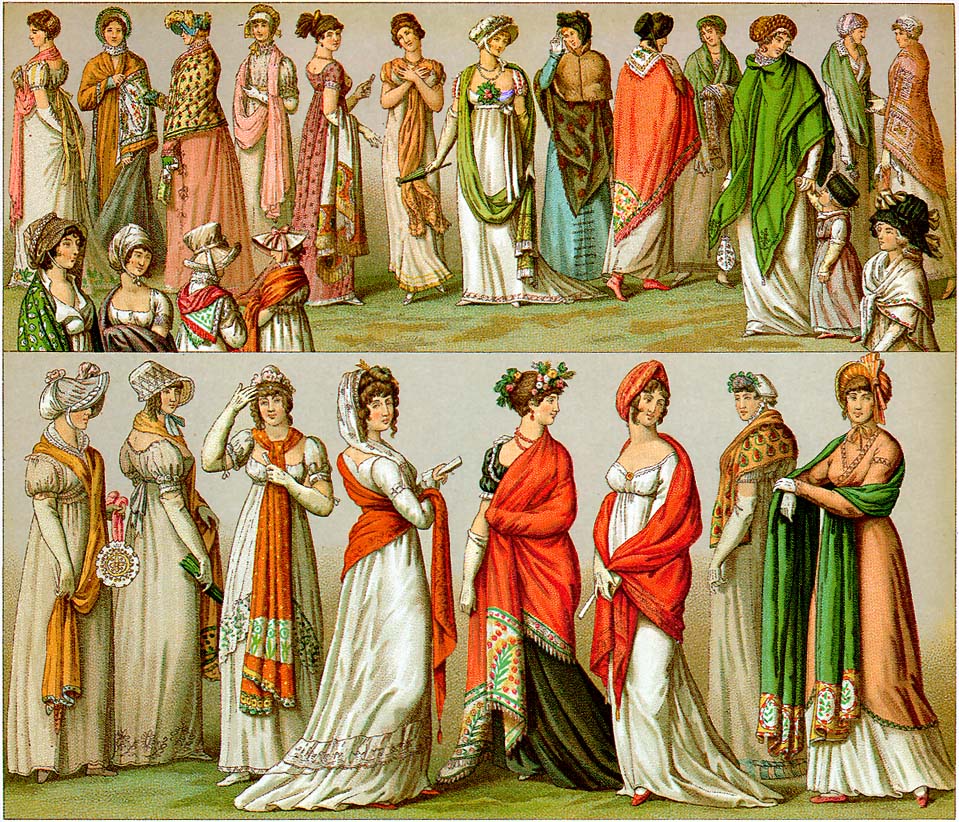
Lithograph plate showing a variety of fashionable ways of draping shawls in early 19th century, France c. 1802-1814; redrawn from various early 19th-century sources by
Durin for Albert Charles Auguste Rancits’s Le Costume Historique (1888); Source: Public domain

Fashion Plate: Title Women 1846-1847, Plate 044, Gift of Woodman Thompson; Source: Fashion Plates 1790-1929, Costume Institutes Fashion Plates, Metropolitan Museum of Art, New York
With the British East India Company’s strong presence in India by the 18th century, importing of large quantities of shawls for the European market began in Great Britain. In France, Empress Josephine, and her contemporary courtiers such as Madame Gaudin, helped popularise them among the French nobility.
During this period, intricately designed jamawar shawls inspired from the silk brocades of Central Asia brought by the traders from Samarkand and Bukhara and adopted in pashmina wool were commonly used by both men and women of the subcontinent. Traditionally woven on a hand-drawn loom (draw loom), an original Kashmir shawl in typical kani (twill tapestry) weave using wooden bobbins took over a year to complete. Parts of the shawl were usually woven on different looms and then darned together by expert darners or rafugar to make a full piece. These were the original traditional pieces that were exported. However, the rise in demand from European markets eventually led to Great Britain and France localising the manufacturing of these shawls, and becoming both leaders and rivals
While there were certainly similarities between the shawls produced in Great Britain and those produced in Kashmir, there were also some notable differences. For example, while Kashmir shawls were typically made of fine wool, European manufacturers often used other materials, such as silk and sometimes even cotton and coarser wool, to create their shawls. Additionally, Kashmir shawls were decorated with intricate embroidery and beading while European manufacturers often relied on simple designs with almost plain grounds which required less labour-intensive techniques to create their shawls.
In Europe, France took the lead by establishing the first-ever manufacturing units of their kind in both Paris and Lyon. Great Britain was close to follow with Paisley, Norwich, and Edinburgh as its major centres. Beginning from 1808, the shawl manufacturing industry in the town of Paisley in Scotland thrived for a stretch of nearly seventy years, to the point where the name of the town – Paisley – became synonymous with the Indo-Persian teardrop motif otherwise known as buta (Anglicised: boteh) in the Indian subcontinent. According to research conducted in 2009, the annual turnover of the industry in current value “at first price” – i.e., before adding taxes, fees of manufacturers and brokers, and profits of middlemen – amounted to around 17 million GBP or 25 million USD.
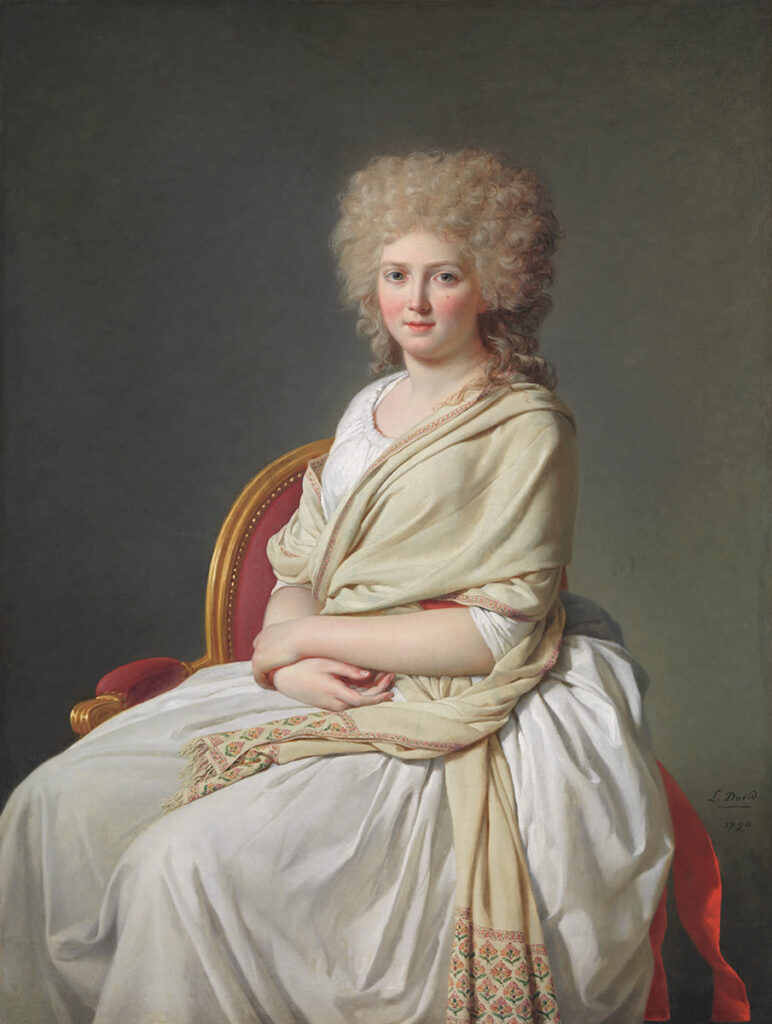
Anne-Marie-Louise Thélusson, Comtesse de Sorcy, by Jacques-Louis David, c. 1790, Source: Bayerische Staatsgemäldesammlungen – Neue Pinakothek München

Portrait of Yelizaveta Demidova by Robert Lefevre, c.1805; Source: The State Hermitage Museum St Petersburg, Russia
One of the key differences between the shawls produced in Great Britain and those produced in France was the use of colour. While the British shawls were typically decorated with muted, earthy tones, French shawls often featured vibrantly bright and bold colour palettes that were designed to stand out. Additionally, French shawls were often made of more luxurious silk and finer wool, which gave them a far more refined and sophisticated look.
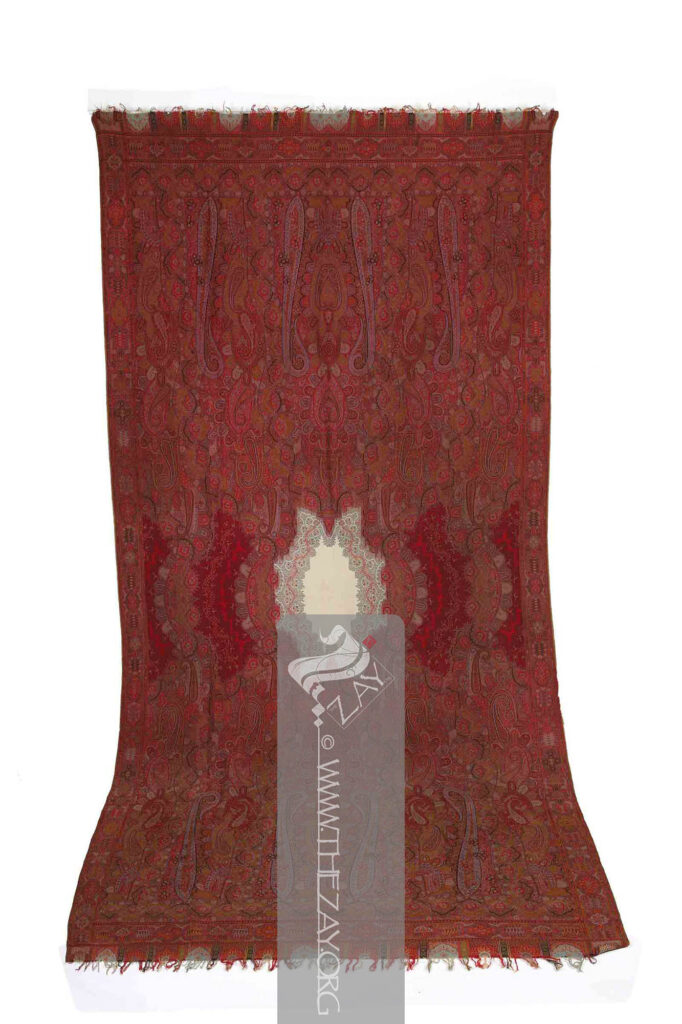
A colourful woven shawl possibly made in France c. 1860; Acc No: ZI2020.500774 EUROPE; Source: The Zay Initiative
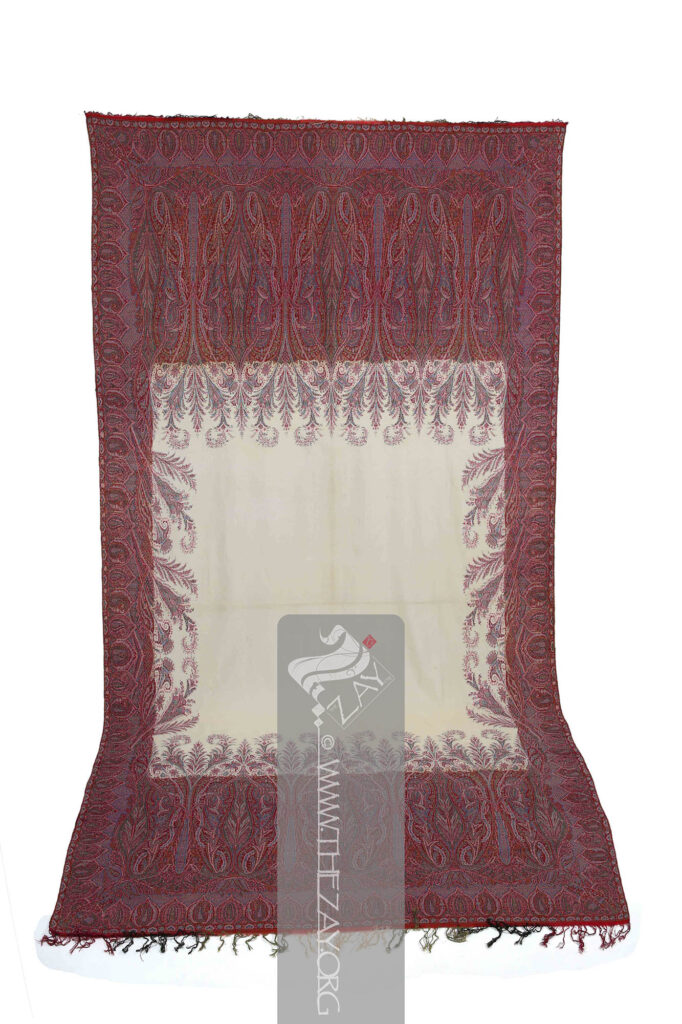
Ivory and Crimson paisley long shawl, Paisley c. 1845-55; Acc No: ZI2020.500780 EUROPE; Source: The Zay Initiative
It is important to note that both Paisley and Norwich in Great Britain already had an existing and thriving textile industry since the settlement of the Flemish weavers in the 16th century. However, these looms were not equipped to execute the elaborate designs often featured in original Kashmir shawls because of the lack of suitable quality of yarn. Multiple failed efforts to copy the quality of the fine wool from Kashmir limited the European copies to silk and coarser wool, in comparison to the lightweight pashmina. This is the reason why the early “Paisley shawls” – the ones brought from India – are quite different from the latter ones, manufactured in the 19th century.
By the 1820s, the town of Norwich in England was fast becoming a competitor of its Scottish counterparts, especially Paisley. Many Norwich firms produced high-quality shawls that were exported worldwide. However, it was not until the mid-19th century that the shawl industry in Norwich reached its peak.
The Norwich shawl industry became famous for its innovative designs and high-quality craftsmanship, and many of the shawls produced during the mid-19th century were considered works of art. The industry employed many skilled workers, including weavers, dyers, and designers, and was an important source of employment in the region with manufacturers like Towler and Campin who enjoyed the royal patronage of both Queen Victoria and Empress Eugénie of France, and E F Hinde whose shawls were so highly sought after that they were sold at prestigious department stores such as Harrods and Selfridges.
The intersection between political and economic factors due to Britain’s imperialistic pursuits coupled with the Industrial Revolution resulted in the appropriation of these beautiful shawls, much like other items from the East. For example, although Queen Victoria owned several luxurious shawls made in Kashmir, she opted to wear British-made shawls in public to show her support for the local industry.
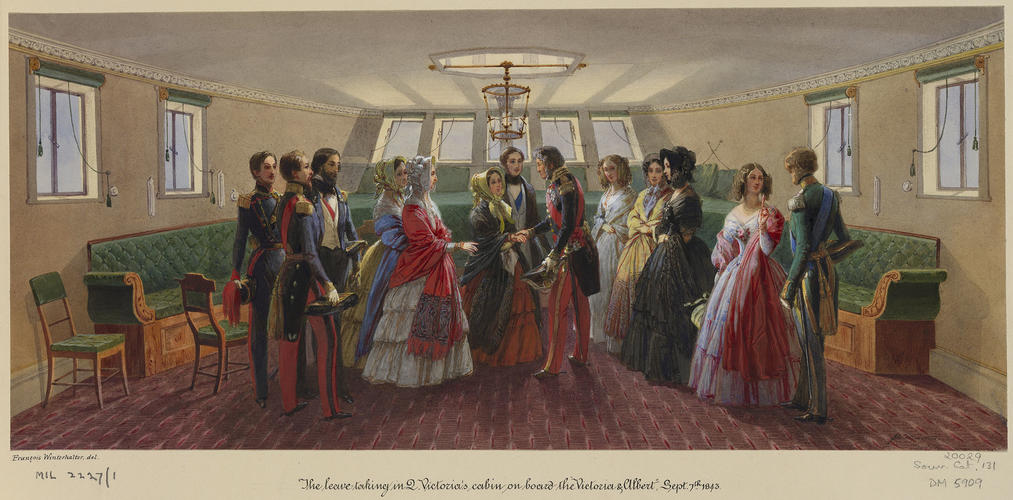
Louis-Philippe taking leave of Queen Victoria on board the royal yacht by Franz Xaver Winterhalter, c. 1843; Source: Victoria & Albert: Our Lives in Watercolour, Royal Collections Trust
Before the introduction of the jacquard loom in the 1820s, shawl makers in Europe were unable to weave a shawl selvedge to selvedge along with its border as one piece.
As a result, the body of the shawl was often stitched to its borders. These shawls were often made of woven woollen borders stitched to the plain square ground in silk or long rectangular silk body with woollen weave decorating the warp ends in broad panels and thin borders woven separately in wool stitched to the weft ends.
From the late 18th century and all through the 19th century, shawls of different styles rose to popularity and made their individual niche in the market. Perhaps the most prominent of them all are the Kirking, the Moon, the Turnover, and finally the Delhi details of which will be covered in the next blog.
